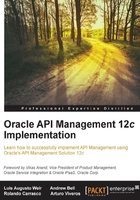
Conventions
In this book, you will find a number of text styles that distinguish between different kinds of information. Here are some examples of these styles and an explanation of their meaning.
Code words in text, database table names, folder names, filenames, file extensions, pathnames, dummy URLs, user input, and Twitter handles are shown as follows: "Each schema can reference definitions in other schemas by making use of the xsd:import directive."
A block of code is set as follows:
./harvest -url http://localhost:7101/oer -user admin -password <password> -file ./test/samples
When we wish to draw your attention to a particular part of a code block, the relevant lines or items are set in bold:
<soapenv:Body>
<wbcv:getSubscriberBalance>
<subscriberID>${http.querystring.attribute}</subscriberID>
</wbcv:getSubscriberBalance>
</soapenv:Body>
Any command-line input or output is written as follows:
PATH=<JAVA_HOME>/bin:$PATH export PATH
New terms and important words are shown in bold. Words that you see on the screen, for example, in menus or dialog boxes, appear in the text like this: "Finally, review the entered installation details using the summary screen and hit the Create button when you are happy."